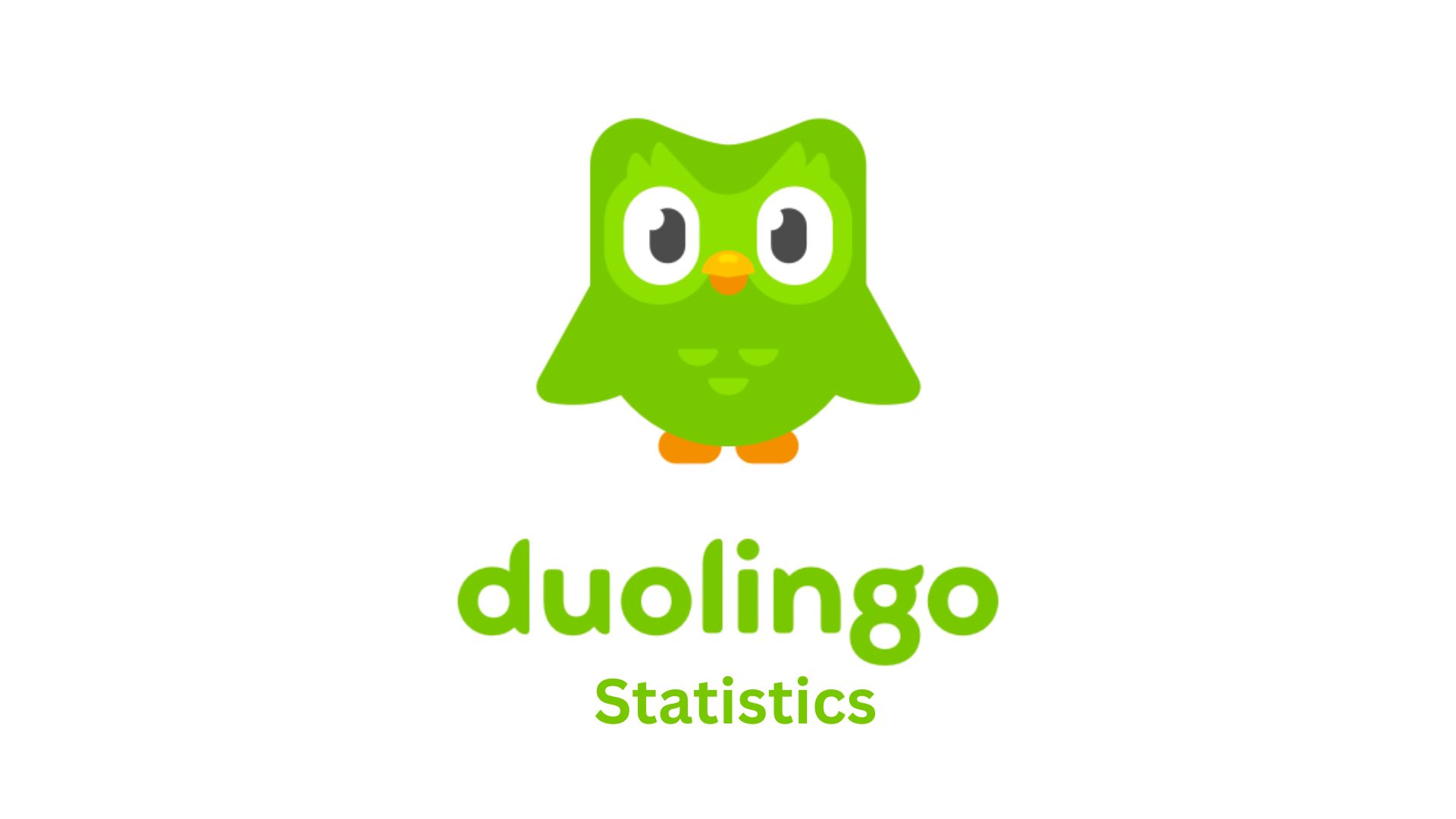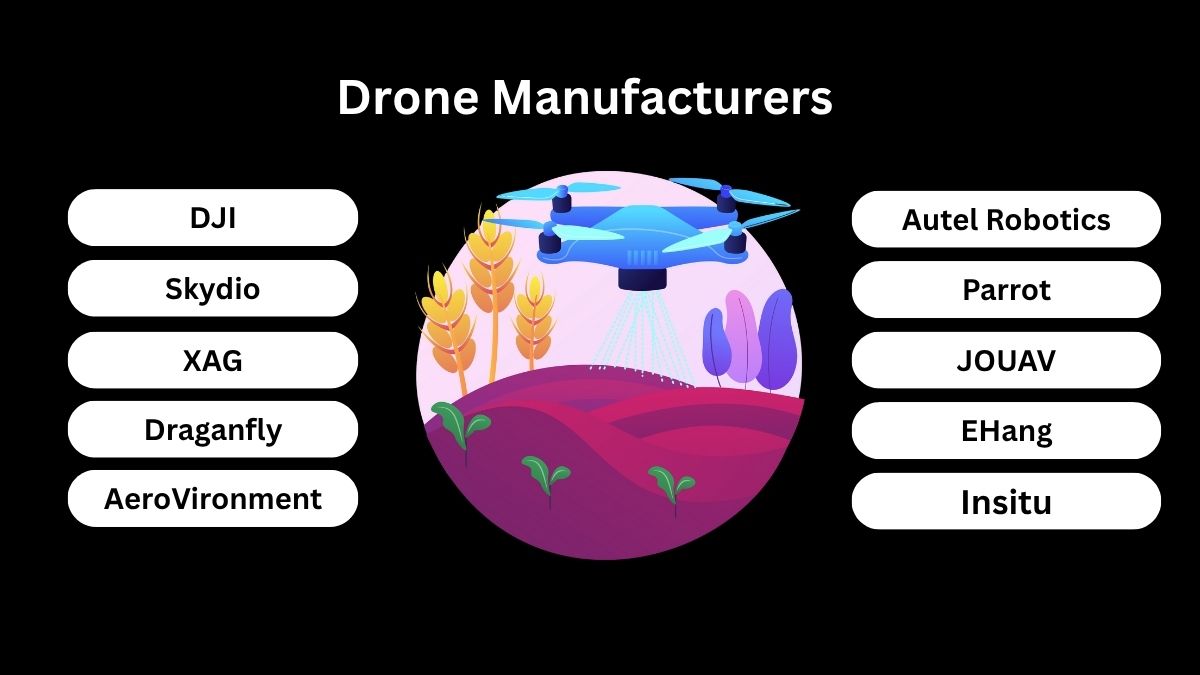Voice Commerce Statistics And Facts (2025)
Updated · Jul 02, 2025
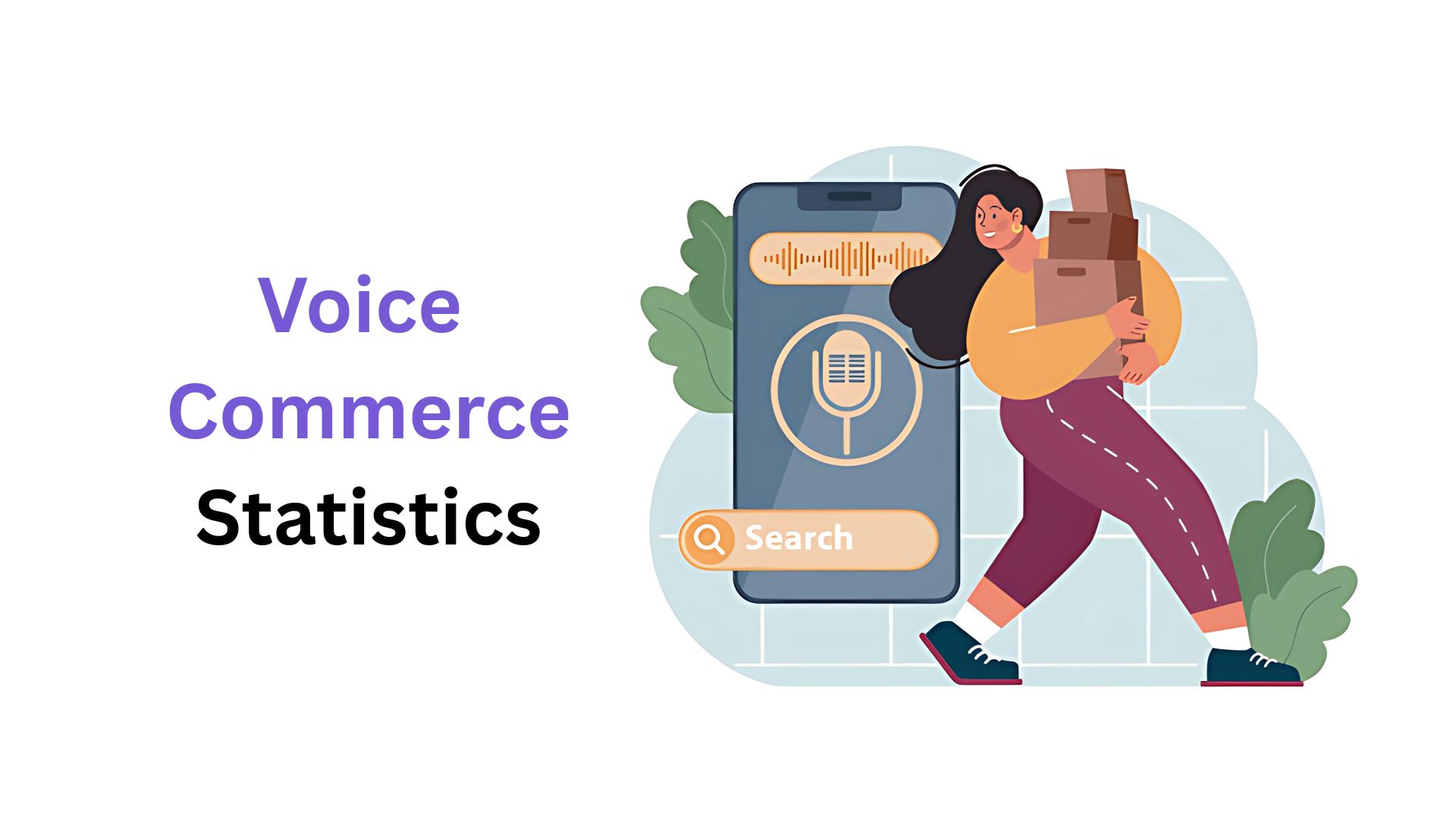
Table of Contents
Introduction
Voice Commerce Statistics: Voice commerce, or v-commerce, is a major buying channel where one uses voice commands via smart speakers or voice-activated assistants embedded in phones or other gadgets. This trend has been heating up in 2024 due to AI progress and the growing number of voice-enabled gadgets. Consumers are loving the convenience, speed, and sheer fun of having things done with voice shopping.
From a business perspective, it gives them a fresh new marketing channel. The article will shed some light on the current Voice Commerce statistics.
Editor’s Choice
- Voice commerce has experienced phenomenal growth in recent years. The market recorded an extraordinary jump of 321.74% from 2021 to 2023, denoting a rapid adoption of voice technology in the shopping arena.
- The year 2024 alone is witnessing a predicted 54.63% increase in the lead growth of voice commerce.
- From a financial perspective, voice-command transactions more than tripled from US$4.6 billion in 2021 to US$19.4 billion in 2023, an indication of rising adoption and trust among consumers.
- 71% of respondents claimed to prefer using voice queries compared to typing data into devices.
- Another survey revealed that 60% of e-commerce shoppers in the U.S. make purchases through their smart home voice assistants either daily or weekly.
- An endorsement of voice commerce evolution is given by acceptance from 80% of those who have done shopping via voice assistants, expressing satisfaction with their purchase experience.
- From 2021 to 2023, voice commerce attained a growth rate of 321.74%, with further growth at 54.63% projected in 2024.
- 8.9 million consumers bought health and beauty products through voice, and 8.8 million bought electronics.
- More than 50% of consumers anticipate that they will use voice assistants for e-commerce within the coming five years.
- 8% of U.S. adults are purchasing stuff online using voice assistants regularly.
- Almost 73% of U.S. drivers who have voice assistants are ready to pay for voice commerce features.
- 88% will pay per transaction, 29% will subscribe, 31% will bear ads, and 29% will share data.
- 84% of drivers prefer the voice assistant in their cars over mobile apps; 94% use it to order food while driving.
Consumer Voice Commerce Uses
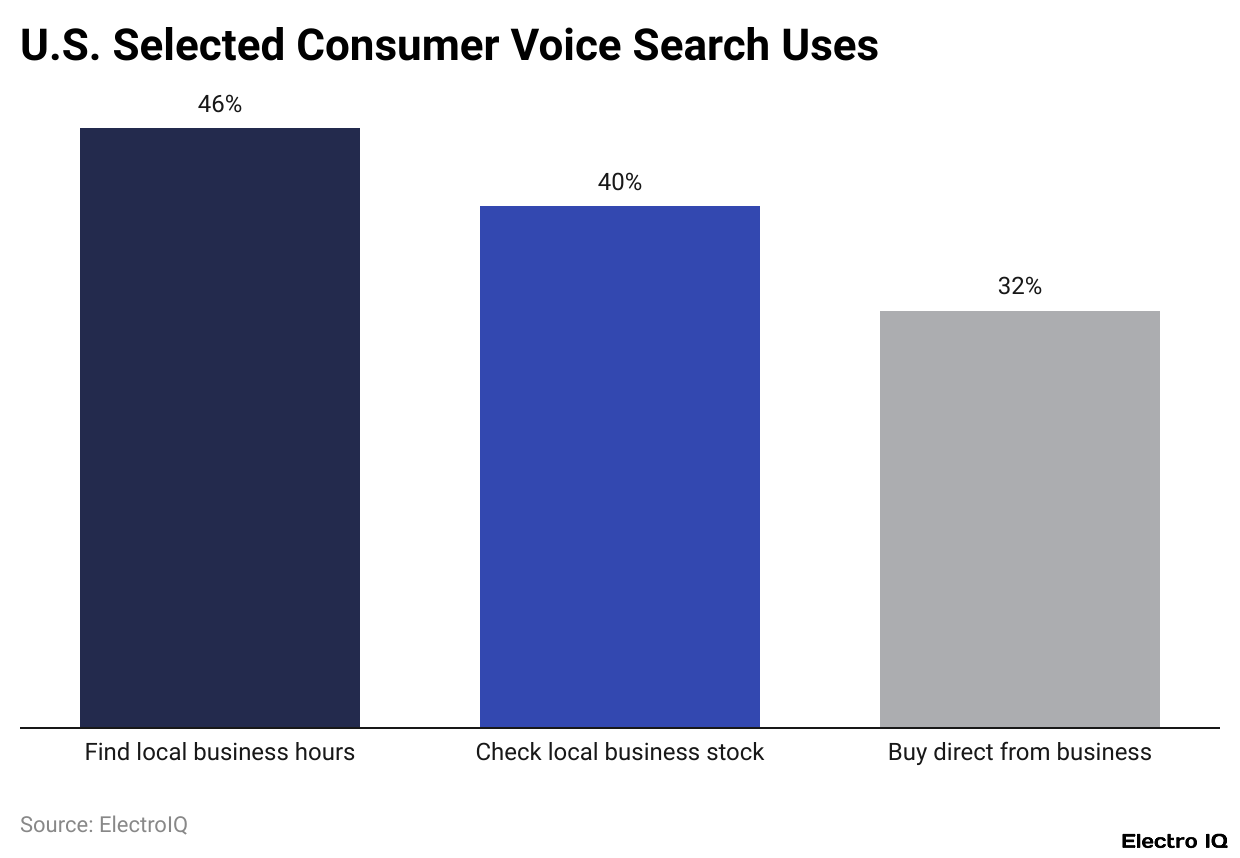
(Reference: capitaloneshopping.com)
- Voice search has become a tremendous tool for both big corporations and small and local businesses.
- 58% of consumers claim to find small and local businesses through voice search, highlighting the tremendous local visibility offered by voice-enabled devices.
- Roughly 46% of the consumers use voice search to check the prices in these stores.
- If we talk about some everyday requirements, then 41% of the people use voice search to find nearby grocery shops, while 40% need to know whether the items are in stock at a certain store.
- Clothes make for another somewhat significant category, with 32% of consumers searching for nearby clothes stores using voice.
- Once a local service is found via voice search, 27% of the users go on to visit the business’s websites.
- Voice search is not something rare at all, as 46% of the users of voice search, representing about 26.7% of all consumers, do so every day to find local businesses.
- Another 28% of voice search users-i.e., 16.2% of total consumers- use it weekly. This proves that there is a substantial number of people interfacing with local services and businesses through voice search on a normal basis.
Voice Shopping Consumer Statistics
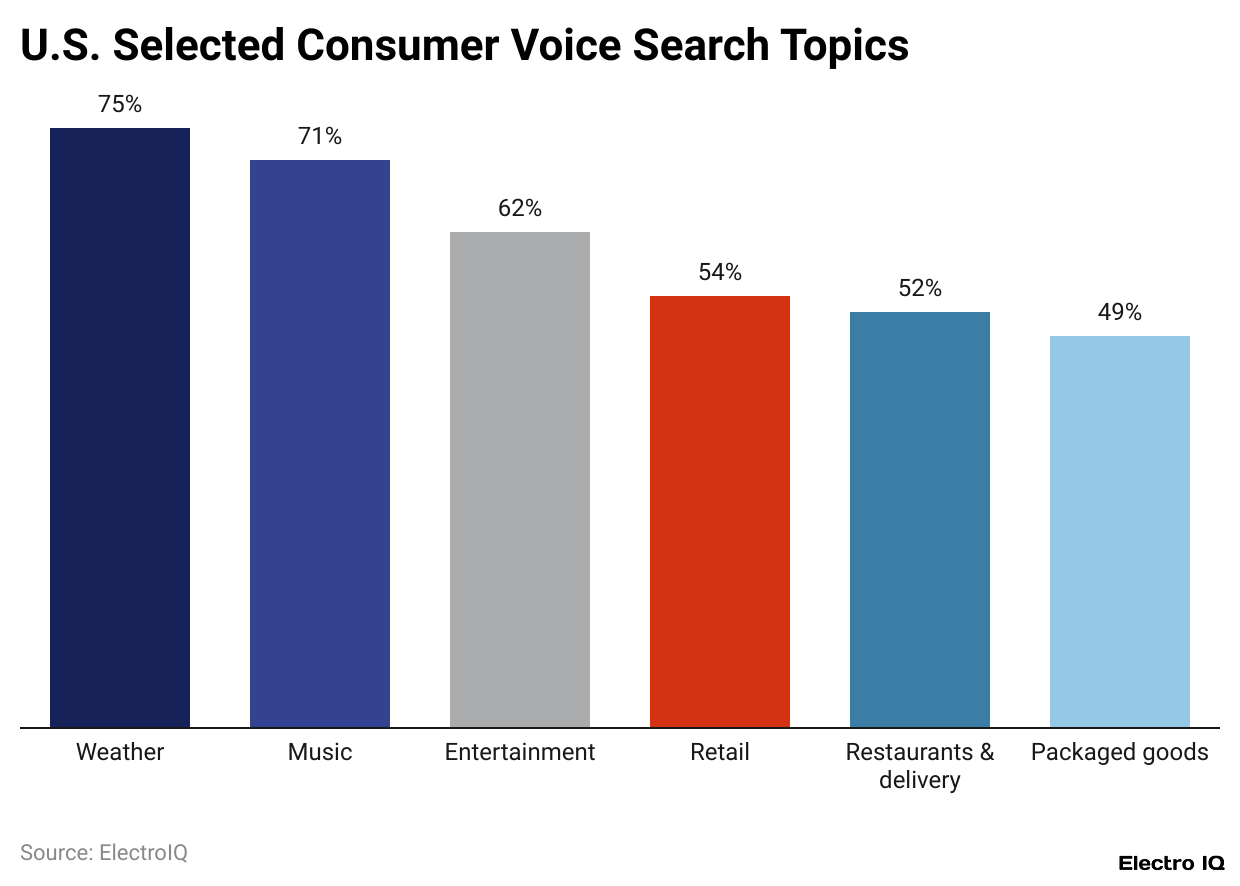
(Reference: capitaloneshopping.com)
- Convenience and speed factor heavily into the voice shopping experience.
- 49% of voice shopping users find it easier than doing it the conventional way.
- Another 44% say that the process feels faster when using voice commands.
- Almost 33% of users in 2022 claimed that the novelty of voice shopping was at least a partial reason they tried it, fueling curiosity behind initial adoption. Now, voice shopping is evolving into routine activities.
- Approximately 31% of shoppers multitask with their voice assistants while shopping, such as taking care of household chores or driving.
- Another 25% of users take the next step of setting up voice-assisted automation for their purchases, allowing recompense for frequently purchased items without requiring any manual intervention.
- This trend shifts toward voice commerce serving not just as a convenience but also as a time-saving habit for many consumers.
Reasons For Using Voice Commerce
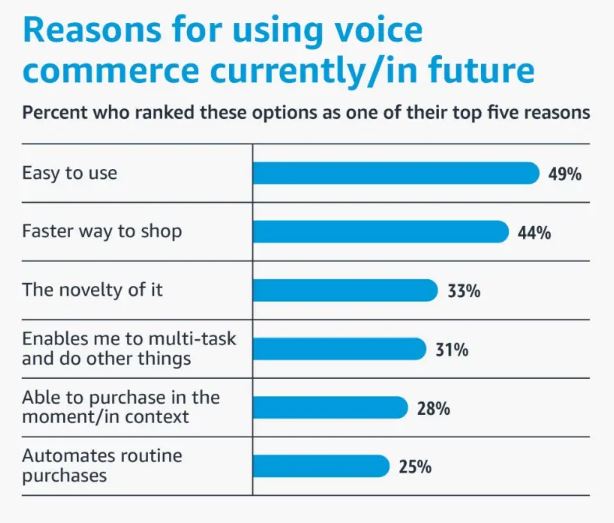
(Source: amazon.com)
- As per Amazon, Voice Commerce statistics state that there are several reasons why people choose voice commerce, with ease of use being the most commonly cited.
- 49% of users said that they liked voice shopping because it was easy.
- Another 44% find it faster to shop by voice than through traditional ways such as typing or browsing through apps or websites.
- About 33% of users say the novelty was the reason they got started with voice shopping. Voice commerce also supports multitasking, and 31% of users would take advantage of this to shop while multitasking, such as doing housework, cooking, driving, or working.
- Around 28% would use voice to make in-the-moment purchases, triggered by some impulse.
- Additionally, a quarter of users employ voice assistants to make routine purchases such as replenishing household supplies, making shopping efficient and less of a time sink.
Voice Search Commerce Statistics
- According to Capitaloneshopping, Voice Commerce statistics show that in the U.S., approximately 38.8 million, or 13.6% of the population, utilise smart speakers to accomplish shopping-related activities. These activities include product research, price checking, and adding items to a shopping list.
- Voice search is gaining traction in retail markets both in the U.S. and the U.K., whereas adoption in Germany has stayed constant.
- Currently, more than half of American retail searches are conducted via voice, with about 40% of those in the U.K. or Germany.
- Certain product categories are witnessing significant voice-based purchases; for example, 8.9 million consumers have bought health and beauty products via their smart speakers, and 8.8 million electronic items through voice-enabled platforms.
- Over the next five years, a majority of consumers expect to make purchases with digital voice assistants, thereby driving future growth.
- 8% of U.S. adults report regularly using voice assistants for online shopping at present, thus defining a generation of hands-free commerce by voice.
In-Car Voice Commerce Statistics
- According to Emarketer, Voice Commerce statistics reveal that Voice commerce is gaining popularity among U.S. drivers, primarily those endowed with in-car voice assistants.
- Roughly 73% of these drivers would be willing to pay for the convenience afforded by voice commerce.
- 18% Opine that they are willing to pay per transaction, while 29% are hungry for a subscription-based model.
- Additionally, some drivers may envision other types of value swaps: 31% would accept ads, and 29% would provide data in exchange for access to voice assistant features within their vehicles. Voice assistants rank above mobile apps in terms of usability.
- Approximately 84% of drivers say they prefer to use in-car voice assistants rather than navigate app interfaces. And they positively voice-order food while they drive, about 94%. This will provide a very good opportunity for automakers to generate recurring revenue out of paid services, advertising, and experiences personalised by user data.
- Voice commerce is a natural way to communicate. The speed of human speech averages about 150 words per minute, whereas typing on a smartphone averages only 40 words per minute.
- In the 24 U.S. states where handheld mobile use while driving is banned, these benefits are particularly salient, from the perspective of the Bureau of Transportation Statistics.
- So, voice commerce means a little added convenience while being compatible with safety regulations and driving behaviour.
Voice Commerce Adoption Among Gen Z And Young Consumers
- Voice assistants continue their modest increase of 2.9% as of the current year in the United States.
- It is predicted that in 2024, approximately 48.7% of all U.S. internet users will be capable of using voice assistants.
- The largest jump in adoption is among Gen Z, whose usage rates are climbing faster than any other age group, seeing a 9.1% increase on a year-to-year basis.
- Almost 89.2% of people are accessing these tools through their smartphones. It becomes even more pronounced for Gen Z, with 94.5% using voice assistants as a mobile tool.
- About 23% of buyers globally state that they are using voice-activated smart assistant services to make regular online purchases.
- Another 19% have placed at least one such order, with a large share of activity being pursued by younger buyers. This points out that even as the voice commerce industry finds its feet at the moment, the younger generation is fast setting the pace for future expansion.
Conclusion
Voice Commerce Statistics – Enormous growth is expected for the voice commerce market in 2024. The trend is evident with billions of voice-ready devices in existence, nearly half of U.S. voice shoppers, and rising voice share in conversational commerce. Lightning-fast advancements in AI and NLP have also, therefore, smoothed the way for issues such as data privacy, recognition accuracy, and user trust.
Since voice purchases are projected to make up nearly one-third of e-commerce by 2030, brands and retailers should still prepare themselves; otherwise, they may be late to one of the most rapidly evolving retail channels.
FAQ.
Voice commerce is witnessing rapid growth; the market increased by 321.74% between 2021 and 2023 and is projected to grow by 54.63% in 2024. The transaction volume grew steadily from US$4.6 billion in 2021 to US$19.4 billion in 2023, pointing toward increased consumer trust and adoption.
Among other factors, the main reasons are easier to use, faster shopping, and the fun factor of somewhat unfamiliar voice shopping. Some of these factors include multitasking during shopping, instant purchases, and automatic ordering of standard orders.
Voice search discovers 57.9% of consumers for a small or local business. Users tend to check prices, find grocery stores, check if items are stocked, and find clothing stores (32%). Besides, 27% use voice search to reach a business website, while 26.7% of all consumers use it daily to locate local services.
With 73% of drivers willing to pay for in-car voice assistant features, it ranks as one of the most important services. They prefer pay-per-use (18%), subscription (29%), advertisements (31%), or trade data (29%). About 84% would prefer a voice assistant to a mobile app, and 94% use voice assistants to order food while driving-a win-win for convenience and safety.
In 2024, it is estimated that 48.7% of internet users in the U.S. would use voice assistants, while 94.5% of Gen Z users use them on mobile devices. On a worldwide scale, voice assistants comprise 23% of consumers who use them regularly to make purchases, whereas another 19% have at least tried it once, with the younger buyers being the primary driving force behind it.

Joseph D'Souza founded ElectroIQ in 2010 as a personal project to share his insights and experiences with tech gadgets. Over time, it has grown into a well-regarded tech blog, known for its in-depth technology trends, smartphone reviews and app-related statistics.





